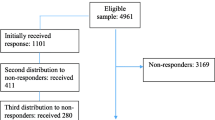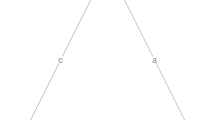Abstract
We conducted two factor-analytic studies of eight depression-related constructs (internal, stable, and global dimensions of attributional style, dysfunctional attitudes, self-esteem, reassurance-seeking, and cognitive and somatic depressed symptoms) among 673 undergraduates. Study 1's exploratory factor analysis revealed that the attributional stability and globality dimensions comprised an Attributional Generality factor; that dysfunctional attitudes and self-esteem loaded onto a separate factor labeled Self-Regard; and that cognitive and somatic depressed symptoms made up their own separate factor, which also included self-esteem. Study 2's LISREL confirmatory factor analyses confirmed Study 1's findings. Results on attributional internality and reassurance-seeking were equivocal. We discuss the implications of the results for depression theory and research.
Similar content being viewed by others
References
Abramson, L. Y., Metalsky, G. I., & Alloy, L. B. (1989). Hopelessness depression: A theory-based subtype of depression.Psychological Review, 96, 358–372.
Bandura, A. (1989). Human agency in social cognitive theory.American Psychologist, 44, 1175–1184.
Barnett, P. A., & Gotlib, I. H. (1988). Psychosocial functioning and depression: Distinguishing between antecedents, concomitants, and consequences.Psychological Bulletin, 104, 97–126.
Beck, A. T. (1983). Cognitive therapy of depression: New perspectives. In P. Clayton & J. E. Barret (Eds.),Treatment of depression: Old controversies and new approaches (pp. 265–290). New York: Raven Press.
Beck, A. T., Rush, A. J., Shaw, B. F., & Emery, G. (1979).Cognitive therapy of depression. New York: Guilford Press.
Beck, A. T., & Steer, R. A. (1987).Manual for the revised Beck Depression Inventory. San Antonio, TX: Psychological Corporation.
Beck, A. T., Steer, R., & Garbin, M. (1988). Psychometric properties of the Beck Depression Inventory: 25 years of evaluation.Clinical Psychology Review, 8, 77–100.
Beck, A. T., Ward, C. H., Mendelson, M., Mock, J., & Erbaugh, J. (1961). An inventory for measuring depression.Archives of General Psychiatry, 4, 561–571.
Billings, A. G., Cronkite, R. C., & Moos, R. H. (1983). Social-environmental factors in unipolar depression: Comparisons of depressed patients and nondepressed controls.Journal of Abnormal Psychology, 92, 119–133.
Butler, A. C., Hokanson, J. E., & Flynn, H. A. (1994). A comparison of self-esteem lability and low trait self-esteem as vulnerability factors for depression.Journal of Personality and Social Psychology, 66, 166–177.
Byrne, B. M. (1989).A primer for LISREL. New York: Springer-Verlag.
Cattell, R. B. (1966). The scree test for the number of factors.Multivariate Behavioral Research, 3, 245–276.
Coyne, J. C. (1976). Toward an interactional description of depression.Psychiatry, 39, 28–40.
Coyne, J. C. (1994). Self-reported distress: Analog or ersatz depression?Psychological Bulletin, 116, 29–45.
Dobson, K. S., & Breiter, H. J. (1983). Cognitive assessment of depression: Reliability and validity of three measures.Journal of Abnormal Psychology, 92, 107–109.
Garber, J., Weiss, B., & Shanley, N. (1993). Cognitions, depressive symptoms, and development in adolescents.Journal of Abnormal Psychology, 102, 47–57.
Gorsuch, R. (1983).Factor analysis. Hillsdale, NJ: Erlbaum.
Gotlib, I. H., Lewinsohn, P. M., Seeley, J. R., & Rhode, P. (1991, November).Cognition in depression: A separation of pessimism and attributional style. Paper presented at the Sixth Annual Meeting of the Society for Research in Psychopathology, Boston.
Gotlib, I. H. Lewinsohn, P. M., Seeley, J. R., Rhode, P., & Redner, J. E. (1993). Negative cognitions and attributional style in depressed adolescents: Examination of stability and specificity.Journal of Abnormal Psychology, 102, 607–615.
Hammen, C. L., & Padesky, C. (1977). Sex differences in the expression of depressive responses on the Beck Depression Inventory.Journal of Abnormal Psychology, 86, 609–614.
Hewitt, P. L., & Flett, G. L. (1993). Dimensions of perfectionism, daily stress, and depression: A test of the specific vulnerability hypothesis.Journal of Abnormal Psychology, 102, 58–65.
Holahan, C. J., & Moos, R. H. (1991). Life stressors, personal and social resources, and depression: A 4-year structural model.Journal of Abnormal Psychology, 100, 31–38.
Ingram, R. E. (1990). Depressive cognition: Models, mechanisms, and methods. In R. E. Ingram (Ed.),Contemporary psychological approaches to depression: Theory, research, and treatment (pp. 169–195). New York: Plenum Press.
Joiner, T. E., Jr., Alfano, M. S., & Metalsky, G. I. (1992). When depression breeds contempt: Reassurance-seeking, self-esteem, and rejection of depressed college students by their roommates.Journal of Abnormal Psychology, 101, 165–173.
Jöreskog, K. G., & Sörbom, D. (1989).LISREL 7: A guide to the program and applications (2nd ed.). Chicago: Statistical Package for the Social Sciences.
Kaiser, H. (1961). A note on Guttman's lower bound for the number of common factors.Multivariate Behavioral Research, 1, 249–276.
Kuiper, N. A., & Olinger, L. J. (1986). Dysfunctional attitudes and a self-worth contingency model of depression. In P. C. Kendall (Ed.),Advances in cognitive-behavioral research and therapy (Vol. 5, pp. 115–142). New York: Academic Press.
Kuiper, N. A., & Olinger, L. J. (1989). Stress and cognitive vulnerability to depression: A self-worth contingency model. In R. W. J. Neufeld (Ed.),Advances in the investigation of psychological stress. New York: Wiley.
Kuiper, N. A., Olinger, L. J., & MacDonald, M. R. (1988). Vulnerability and episodic cognitions in a self-worth contingency model of depression. In L. B. Alloy (Ed.),Cognitive processes in depression. New York: Guilford Press.
Lewinsohn, P. M. (1975). Engagement in pleasant activities and depression level.Journal of Abnormal Psychology, 84, 729–731.
Metalsky, G. I., Halberstadt, L. J., & Abramson, L. Y. (1987). Vulnerability to depressive mood reactions: Toward a more powerful test of the diathesis-stresses and causal mediation components of the reformulated theory of depression.Journal of Personality and Social Psychology, 52, 386–393.
Metalsky, G. I., & Joiner, T. E. Jr., (1992). Vulnerability to depressive symptomatology: A prospective test of the diathesis-stress and causal mediation components of the hopelessness theory of depression.Journal of Personality and Social Psychology, 63, 667–675.
Metalsky, G. I., Joiner, T. E., Jr., Hardin, T. S., & Abramson, L. Y. (1993). Depressive reactions to failure in a naturalistic setting: A test of the hopelessness and self-esteem theories of depression.Journal of Abnormal Psychology, 102, 101–109.
Metalsky, G. I., Joiner, Jr., T. E., & Potthoff, J. G. (1996).Development, specificity and predictive validity of the Depressive Interpersonal Relationships Inventory. Manuscript in preparation.
Nolen-Hoeksema, S. (1987). Sex differences in unipolar depression: Evidence and theory.Psychological Bulletin, 101, 259–282.
Nolen-Hoeksema, S. (1990).Sex differences in depression. Stanford, CA: Stanford University Press.
Nunnally, J. (1978).Psychometric theory. New York: McGraw-Hill.
Peterson, C. R., & Seligman, M. E. P. (1984). Causal explanations as a risk factor for depression: Theory and evidence.Psychological Review, 91, 347–374.
Peterson, C. R., Semmel, A., von Baeyer, C., Abramson, L. Y., Metalsky, G. I., & Seligman, M. E. P. (1982). The Attributional Style Questionnaire.Cognitive Therapy and Research, 6, 287–300.
Rehm, L. P. (1977). Self-control model of depression.Behavior Therapy, 8, 787–804.
Reno, R. M., & Halaris, A. E. (1989). Dimensions of depression: A comparative longitudinal study.Cognitive Therapy and Research, 13, 549–564.
Roberts, J. E., & Monroe, S. M. (1991). Vulnerable self-esteem and depressive symptoms: Prospective findings comparing three alternative conceptualizations.Journal of Personality and Social Psychology, 62, 804–812.
Robins, C. J., & Block, P. (1989). Cognitive theories of depression viewed from a diathesis-stress perspective: Evaluations of the models of Beck and Abramson, Seligman, and Teasdale.Cognitive Therapy and Research, 13, 297–313.
Rosenberg, S. (1965).Society and the adolescent self-image. Princeton, NJ: Princeton University Press.
Rudd, M. D., Rajab, H., & Dahm, P. F. (1994). Problem-solving appraisal in suicide ideators and attempters.American Journal of Orthopsychiatry, 64, 136–149.
Seligman, M. E. P., Abramson, L. Y., Semmel, A., & von Baeyer, C. (1979). Depressive attributional style.Journal of Abnormal Psychology, 88, 242–247.
SPSS. (1988).SPSS-X user's guide (3rd ed.). Chicago: Author.
Sweeney, P. D., Anderson, K., & Bailey, S. (1986). Attributional style in depression: A metaanalytic review.Journal of Personality and Social Psychology, 50, 974–991.
Tanaka, J. S., & Huba, G. J. (1984). Confirmatory hierarchical factor analyses of psychological distress measures.Journal of Personality and Social Psychology, 3, 621–635.
Tobin, D. L., Johnson, C., Steinberg, S., Staats, S., & Dennis, A. B. (1991). Multifactorial assessment of bulimia nervosa.Journal of Abnormal Psychology, 100, 14–21.
Vredenburg, K., Flett, G. L., & Krames, L. (1993). Analogue versus clinical depression: A critical appraisal.Psychological Bulletin, 113, 327–344.
Weissman, A. N. (1979). The Dysfunctional Attitude Scale: A validation study (Doctoral dissertation, University of Pennsylvania, 1978).Dissertation Abstracts International, 40, 1389B-1390B.
Author information
Authors and Affiliations
Additional information
Preparation of this article was supported, in part, by a Young Investigator Award to Thomas Joiner from the National Alliance for Research on Schizophrenia and Affective Disorders (NARSAD), by a Research Grant to Thomas Joiner from the University of Texas Medical Branch at Galveston, the funds of which derive from the Pearl and Aaron Forman Research Foundation and the John Sealy Memorial Endowment Fund, and by a grant to M. David Rudd from the National Institute of Mental Health (MH48097).
Rights and permissions
About this article
Cite this article
Joiner, T.E., David Rudd, M. Toward a categorization of depression-related psychological constructs. Cogn Ther Res 20, 51–68 (1996). https://doi.org/10.1007/BF02229243
Issue Date:
DOI: https://doi.org/10.1007/BF02229243




